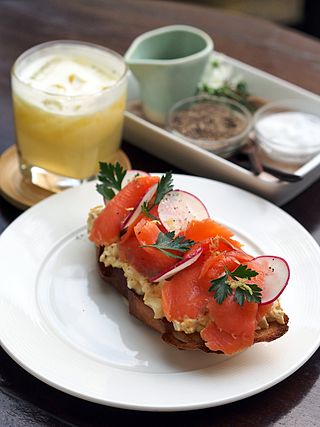
Sushi is a Japanese dish of prepared vinegared rice, usually with some sugar and salt, a variety of ingredients, such as seafood — often raw — and vegetables. Styles of sushi and its presentation vary widely, but the one key ingredient is "sushi rice", also referred to as shari (しゃり), or sumeshi (酢飯).

Salmon is the common name for several commercially important species of euryhaline ray-finned fish from the genera Salmo and Oncorhynchus of the family Salmonidae, native to tributaries of the North Atlantic (Salmo) and North Pacific (Oncorhynchus) basins. Other closely related fish in the same family include trout, char, grayling, whitefish, lenok and taimen, all coldwater fish of the subarctic and cooler temperate regions with some sporadic endorheic populations in Central Asia.

Sashimi is a Japanese delicacy consisting of fresh raw fish or meat sliced into thin pieces and often eaten with soy sauce.

Smoked salmon is a preparation of salmon, typically a fillet that has been cured and hot or cold smoked.

The cuisine of California reflects the diverse culture of California and is influenced largely by Hispanic American roots, alongside East Asian and Oceanian influences, and Western European influences, as well as the food trends and traditions of larger American cuisine.

Canadian cuisine consists of the cooking traditions and practices of Canada, with regional variances around the country. First Nations and Inuit have practiced their culinary traditions in what is now Canada since time immemorial. The advent of European explorers and settlers, first on the east coast and then throughout the wider territories of New France, British North America and Canada, saw the melding of foreign recipes, cooking techniques, and ingredients with indigenous flora and fauna. Modern Canadian cuisine has maintained this dedication to local ingredients and terroir, as exemplified in the naming of specific ingredients based on their locale, such as Malpeque oysters or Alberta beef. Accordingly, Canadian cuisine privileges the quality of ingredients and regionality, and may be broadly defined as a national tradition of "creole" culinary practices, based on the complex multicultural and geographically diverse nature of both historical and contemporary Canadian society.

The history of sushi began with paddy fields, where fish was fermented with vinegar, salt and rice, after which the rice was discarded. The earliest form of the dish, today referred to as narezushi, was created in Japan around the Yayoi period. In the Muromachi period (1336–1573), people began to eat the rice as well as the fish. During the Edo period (1603–1867), vinegar rather than fermented rice began to be used. The dish has become a form of food strongly associated with Japanese culture.

Indirect grilling is a barbecue cooking technique in which the food is placed to the side of or above the heat source instead of directly over the flame as is more common. This can be achieved by igniting only some burners on a gas barbecue or by piling coals to one side of a charcoal pit. A drip tray is placed below the food to prevent fat from the food igniting and generating a direct flame. Indirect grilling is designed to cook larger or tougher foods that would burn if cooked using a direct flame. This method of cooking generates a more moderate temperature and allows for an easier introduction of wood smoke for flavoring.

California roll or California maki is an uramaki containing imitation crab, avocado, and cucumber. Sometimes crab salad is substituted for the crab stick, and often the outer layer of rice is sprinkled with toasted sesame seeds or roe.

A Philadelphia roll is a makizushi type of sushi generally made with smoked salmon, cream cheese, and avocado, with the rice on the outside (uramaki). It is sometimes made with imitation crab instead of salmon, but can be found to include other ingredients, such as other types of fish, cucumber, scallions, and sesame seed. Like many Western-inspired sushi rolls, its design and name are modified to target an American market, which includes putting the rice on the outside, and the nori in the inside to appeal to western aesthetics.

Japanese cuisine has a vast array of regional specialities known as kyōdo ryōri (郷土料理) in Japanese, many of them originating from dishes prepared using local ingredients and traditional recipes.
Tyson Cole is a chef and restaurateur based in Austin, Texas, USA.

Like humans and other animals, fish suffer from diseases and parasites. Fish defences against disease are specific and non-specific. Non-specific defences include skin and scales, as well as the mucus layer secreted by the epidermis that traps microorganisms and inhibits their growth. If pathogens breach these defences, fish can develop inflammatory responses that increase the flow of blood to infected areas and deliver white blood cells that attempt to destroy the pathogens.

Sushi pizza is a Canadian dish that originated from Toronto and a fusion of sushi and pizza often served in the Greater Toronto Area, conceptualized by Kaoru Ohsada no later than May 1993 as a Nami Japanese Seafood Restaurant chef. It uses a slightly crispy yet chewy fried rice patty as the base and is topped with a layer of sliced avocado, a layer of sliced salmon, tuna or crab meat, a drizzle of blended mayonnaise and wasabi powder and is served in wedges. Nori, pickled ginger, and roe are sometimes also served as toppings or sides.

Salmon is a common food fish classified as an oily fish with a rich content of protein and omega-3 fatty acids. Norway is a major producer of farmed and wild salmon, accounting for more than 50% of global salmon production. Farmed and wild salmon differ only slightly in terms of food quality and safety, with farmed salmon having lower content of environmental contaminants, and wild salmon having higher content of omega-3 fatty acids.
Hidekazu Tojo is a Japanese-Canadian chef based in Vancouver, British Columbia.














